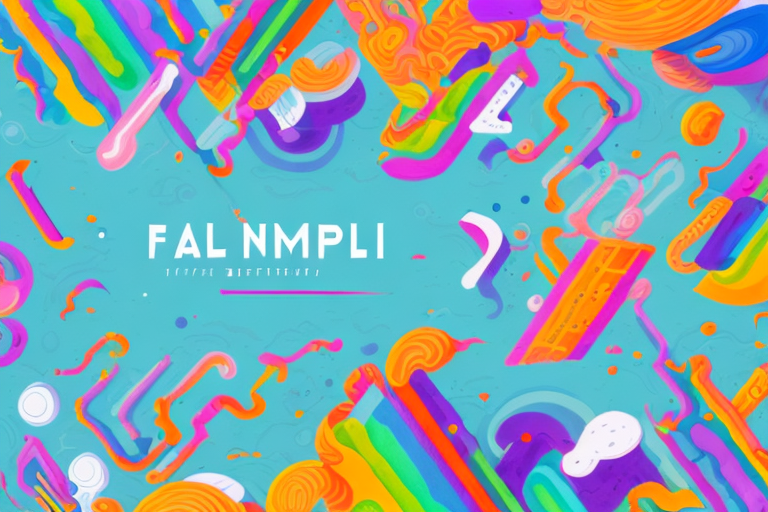
Creating a Fun and Playful Brand Identity
In today's competitive market, it's important to have a brand identity that not only stands out but also connects with your target audience. One way to achieve this is by creating a fun and playful brand identity. But why is a playful brand identity so important?
Understanding the Importance of a Playful Brand Identity
A playful brand identity can help your business in a number of ways. Firstly, it differentiates you from your competitors, making you more memorable and increasing your brand recognition. Secondly, it can help you connect on a deeper level with your target audience, making them more likely to engage with your brand and become repeat customers.
But what exactly is a playful brand identity? It's a visual and verbal representation of your brand that uses humor, creativity, and a sense of playfulness to communicate with your audience. This can be done through your logo, color scheme, website design, packaging, and even your social media posts.
The Benefits of a Fun and Playful Brand
A fun and playful brand is not only memorable but also has a positive impact on the perception of your business. People are more likely to associate a playful brand with positivity, creativity, and innovation. This, in turn, can increase brand loyalty and customer trust. It's also worth noting that a playful brand identity can help you stand out on social media, where creativity and humor are often rewarded with likes and shares.
Another benefit of a playful brand identity is that it can help you attract a younger audience. Millennials and Gen Z value brands that have a sense of humor and don't take themselves too seriously. By incorporating playfulness into your branding, you can tap into this demographic and build a loyal following.
Examples of Successful Playful Brands
Examples of successful playful brands include Dropbox, Innocent Drinks, and Mailchimp. All of these brands have a strong visual identity, an engaging tone of voice, and a sense of humor that runs through all of their communications.
Dropbox, for example, uses playful illustrations and animations in their branding to make their cloud storage service feel more approachable and user-friendly. Innocent Drinks is known for their humorous packaging copy, which often includes puns and jokes. Mailchimp, meanwhile, has a playful tone of voice and regularly sends out fun and educational newsletters to their subscribers.
But it's not just tech companies and trendy beverage brands that can benefit from a playful brand identity. Even traditionally serious industries like finance and healthcare can use humor and playfulness to connect with their audience. For example, the financial planning app, Acorns, uses playful animations and a friendly tone of voice to make saving money feel less intimidating.
In conclusion, a playful brand identity can have numerous benefits for your business, from increased brand recognition to deeper connections with your audience. By incorporating humor, creativity, and a sense of playfulness into your branding, you can set yourself apart from your competitors and build a loyal following.
Defining Your Brand's Personality
If you're ready to create a playful brand identity, the first step is to define your brand's personality. Think about the values you want to convey, and how you want your brand to be perceived.
Creating a brand personality is like creating a character. You want to give your brand a unique identity that sets it apart from your competitors. Consider what kind of personality traits you want your brand to have. Is it quirky and fun-loving, or serious and professional? Is it laid-back and approachable, or sophisticated and refined?
Once you've identified the personality traits you want your brand to have, think about how you can communicate those traits through your brand identity. This includes everything from your logo and color scheme to your website design and social media posts.
Identifying Your Target Audience
Understanding your target audience is key to creating a successful playful brand identity. Who are your customers, and what are their pain points? What kind of content do they engage with on social media?
By answering these questions, you can get a better idea of how to tailor your brand's personality to appeal to your target audience. For example, if your target audience is primarily young adults who are interested in pop culture, you may want to incorporate references to popular TV shows or movies into your brand identity.
It's also important to consider the language and tone that will resonate with your target audience. Are they looking for a brand that is relatable and approachable, or one that is more formal and authoritative?
Determining Your Brand's Core Values
Your brand's core values should be reflected in your brand identity. Think about what your business stands for, and what makes you unique. Your brand values can inform everything from your visual identity to your tone of voice.
For example, if your business is focused on sustainability, you may want to incorporate eco-friendly design elements into your brand identity. If your business is focused on innovation, you may want to use bold and modern design elements.
By aligning your brand's personality with your core values, you can create a brand identity that is authentic and meaningful to your customers.
Creating a Brand Voice and Tone
Your brand voice and tone are key to creating a playful brand identity. Think about how you want to speak to your customers. Should your tone be irreverent and humorous, or more professional and informative?
Establishing a consistent brand voice across all of your communications is essential to creating a cohesive brand identity. This means using the same tone and language in your social media posts, website copy, and customer service interactions.
Remember, your brand personality should be reflected in everything you do. By creating a playful brand identity that resonates with your target audience and aligns with your core values, you can build a strong and memorable brand that stands out in a crowded marketplace.
Designing a Playful Logo and Visual Identity
Your visual identity is an important part of your brand identity, and a playful logo can help set the tone for your entire brand. A playful logo can convey a sense of fun and creativity, and can make your brand more approachable to your target audience. But there's more to a visual identity than just a logo - you'll also need to consider things like color, typography, and imagery.
When it comes to color, it's important to choose colors that reflect the personality of your brand. Colors can have a powerful impact on our emotions and perceptions, so it's important to choose colors that align with your brand values and personality. For example, yellow is often associated with playfulness and optimism, while blue can convey trust and professionalism. By choosing the right colors for your brand, you can create a visual identity that resonates with your target audience and reinforces your brand personality.
The Psychology of Colors in Branding
Colors can have a powerful impact on our emotions, and it's important to choose colors that reflect the personality of your brand. Yellow, for example, is often associated with playfulness and optimism, while blue can convey trust and professionalism. Green is often associated with growth and nature, while red can convey energy and passion. By understanding the psychology of colors in branding, you can choose colors that align with your brand values and personality.
In addition to color, typography can also help to reinforce your brand personality. Playful brands often use rounded or script fonts, while more professional brands may opt for more traditional serif fonts. By choosing the right typography for your brand, you can create a visual identity that communicates your brand personality and values.
Choosing the Right Typography
The right typography can also help to reinforce your brand personality. Playful brands often use rounded or script fonts, while more professional brands may opt for more traditional serif fonts. By choosing the right typography for your brand, you can create a visual identity that communicates your brand personality and values.
Finally, incorporating playful imagery and icons can help to reinforce your brand identity. Look for imagery that reflects your brand values and personality, and consider creating custom icons that can be used across your marketing materials. By incorporating playful imagery and icons into your visual identity, you can create a cohesive and memorable brand that resonates with your target audience.
Incorporating Playful Imagery and Icons
Incorporating playful imagery and icons can help to reinforce your brand identity. Look for imagery that reflects your brand values and personality, and consider creating custom icons that can be used across your marketing materials. By incorporating playful imagery and icons into your visual identity, you can create a cohesive and memorable brand that resonates with your target audience. Whether you're designing a logo, choosing colors, or selecting typography, it's important to keep your brand personality and values at the forefront of your decision-making process.
Developing a Consistent Brand Experience
Creating a consistent brand experience is key to building a strong and recognizable brand identity. This means taking a holistic approach to your branding, and considering every touchpoint that a customer has with your brand.
When developing a brand experience, it's important to keep in mind that every interaction a customer has with your brand should leave a lasting impression. From the moment they discover your brand to the moment they make a purchase, every step of the customer journey should reflect your brand personality and values.
Creating a Cohesive Online Presence
Your online presence is a crucial part of your brand identity, and you'll want to ensure that your website, social media profiles, and other digital properties all reflect your brand personality. This means using the same colors, typography, and imagery across all of your online channels.
In addition to visual consistency, it's also important to create a consistent tone of voice across all of your online channels. This means using the same language and messaging to communicate with your audience, whether you're posting on social media or writing blog posts for your website.
Designing Playful Packaging and Promotional Materials
If your business sells physical products, then your packaging is another opportunity to reinforce your brand identity. Consider using playful illustrations or copy on your packaging to make your products stand out on the shelf.
When designing your packaging, it's important to keep in mind that it should not only be visually appealing, but also functional and informative. Your packaging should clearly communicate the benefits of your product and make it easy for customers to understand how to use it.
Ensuring a Fun and Engaging Customer Experience
Finally, it's important to ensure that every customer interaction with your brand is fun and engaging. This could mean using playful copy in your marketing materials, or offering interactive experiences on your website or social media profiles.
One way to create a fun and engaging customer experience is to offer personalized recommendations based on a customer's past purchases or browsing history. This not only makes the customer feel valued, but also helps to increase customer loyalty and repeat purchases.
Creating a fun and playful brand identity can take some work, but the benefits are clear. By differentiating yourself from your competitors, connecting on a deeper level with your target audience, and building a strong and recognizable brand identity, you can set your business up for long-term success.
